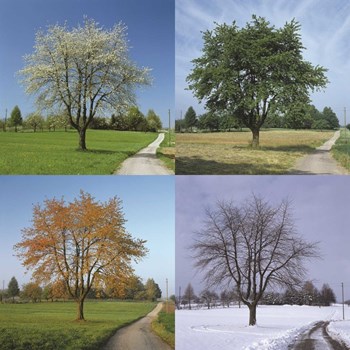
With a light sprinkling of freshly fallen snow blanketing your building's landscape, it’s easy to be lulled into thinking your property really is "pretty as a picture.” Sure, the occasional snowfall New York City experiences transform the Big Apple into a beautiful winter wonderland. But keep in mind that when the snow melts, an array of blemishes created by winter's harsh blasts will be revealed.
This quiet period when board members are tucked comfortably indoors offers an opportunity to contemplate the balmier seasons to come—and to review the association’s checklist of tasks that should be completed before residents want to enjoy the community grounds.
Spring Cleaning 101
The severity of winter damage varies from building to building, so a thorough walk through is the first step to assessing problem areas and creating a plan of action.
“We have a program in our office where we do monthly full-blown inspections and we share it with our boards,” says Steven Greenbaum, the vice president of New York City and Long Island-based Mark Greenberg Real Estate (MGRE). “We realize that not every time a property manager goes to their property or a super goes walking through their building, they go top to bottom, front to back, side to side and get into every little corner. So we've created a checklist and inspection report that makes the manager go through everything.”
The list of areas to inspect is quite lengthy but pros stress the importance of leaving no nook or cranny unturned.
“Managers and building staff should inspect all roof areas to determine if and how winter weather has damaged the roof, flashings, parapet walls, or other exterior elements,” Doug Weinstein, the director of operations for AKAM Associates, Inc. New York City-based office, says. “All exterior drains should be inspected to ensure they are clear of any debris that might have entered during the winter months.”
Managers and supers should also use this time to test HVAC and other mechanical systems.
“HVAC systems are much more difficult than boilers,” Greenbaum says. Although everybody worries about getting boilers ready for the winter, I'm more concerned about getting my air conditioning system running for the summer. They tend to be a little temperamental. So, we're on it. We start running test programs in mid-February.”
“Those buildings with central air conditioning systems should perform their annual maintenance including filter changes, anti-clog tablets, and blow-down of condensate lines,” Weinstein adds.
Winter increases the risk for cracks in building floors, surfaces and facades due to freeze thaw, Mario Sciacca, the vice president of Brooklyn-based building maintenance and repair company, Etna Contracting, Inc., says. “During winter a building will get freeze thaw. If water gets in a certain crack within the facade or the sidewalk, it will freeze and expand. While it expands, it starts to form cracks. It could happen in the facade in the brick.” Sciacca recommends filling any cracks with pointing cement and checking caulking around windows.
Most building boards and associations are aware of the liability they face if a resident slips and falls on ice or snow during the frosty winter months. Sidewalks and curbs are most prone to winter damage, due to a mixture of elements like rain, sleet, snow, ice and the most vicious culprit of all, salt, Sciacca says. Water can get seep through expansion joints, causing sidewalks to crack and heave, making them especially dangerous and trip-prone. It’s essential to have professionals inspect sidewalks and curbs carefully to prevent slips and falls and possible liability.
Curb Appeal
Despite what well-intentioned mothers tell their children, looks really do matter, especially the looks of a building, the experts say. After building safety concerns are addressed, the next most important step in spring-cleaning is polishing all aspects of the building to a sparkling shine.
“First of all, the aesthetic issue is very important. Curb appeal is always paramount,” Greenbaum says. “Before spring time, you start looking at what needs to be repainted, what got rusted out, what got eroded, what needs to be honed and polished—all that stuff that makes the area look great.”
The remnants of winter need to be removed, not only to improve appearances, but also to protect the property from further damage. Dirt tracked from parking lots and sidewalks can create havoc with carpets and flooring, causing unnecessary wear and forcing premature replacement. Weinstein says managers and maintenance staff should establish a program that specifically addresses curb appeal. It should include tasks such as steam cleaning the building canopy, and polishing and refinishing any metal or wood elements, he says. The lobby and other common area floors need to be deep cleaned (steam cleaned if the floors are carpeted) and polished if applicable (granite and marble floors). Additionally, cold weather floor coverings, such as snow mats should be cleaned and stowed away for next winter.
When the weather warms up, people will be dying to go outside and enjoy the outside elements of their buildings, which might include a community pool, fountains, benches and tennis and basketball courts. Greenbaum is sure to inspect every little detail of these amenities to ensure they are ready to be enjoyed when residents emerge from their winter hibernation.
Benches must be inspected for paint chipping, rusting and splintering of wood or loose screws. Fountains should be cleaned, repainted if needed, and pumps serviced. Tennis courts and the like should be checked for surface cracks and repainted. Pools should be cleaned and inspected thoroughly, Greenbaum says.
“Pools are very important to do full-blown inspections. We're turning out our pools in April, so we're doing full-blown inspections and doing test runs on them to test lighting and all kind of things you need to do,” he says.
A lot of people use their spring-cleaning time to organize their closets, update their wardrobes and get rid of unwanted items. The same should be done for building staff. Greenbaum is sure to switch up doormen/doorwomen and other applicable building staffs’ uniforms come springtime to make them more weather appropriate.
A Tree Grows in Brooklyn… and All Over
When talking about curb appeal in an urban environment, don’t forget the plantings and trees that make a property look good. There are over 5.2 million trees in New York City, of which there are about 593,000 street trees, according to a 2006 survey by the New York City Parks Department. However, not all plantings can thrive in an urban environment like the Big Apple, which has more than its fair share of car exhaust, foot traffic and dog waste.
“Gingko is a very common tree in New York City. It dates back to the prehistoric days, it’s also in my opinion the most beautiful, it has a leaf that looks like a fan.” says Kim Johnson, founder of Manhattan-based Curb Allure, a licensed tree guard contractor. “You’ll also find a lot of different styles of oaks as well as honey locust and callery pear. But what we are trying to do in New York City is diversify. In the past you saw streets lined with the same tree. Then it was figured out that if one tree gets a disease it’s going to be much more likely to pass that on to the like trees.”
Just as there are trees that thrive in a New York City environment there are others that are not recommended. “The Norway Maple is not planted anymore,” explains Johnson. “They lifted the sidewalks, so if you walk down a sidewalk some of the lifting is probably caused from a Norway maple. Fruit trees are not recommended. You don’t want to have fruit trees on the sidewalk because of rats, when the fruits drops the rats could come out of the woodwork. Another reason is when the fruit drops it’ll get slippery and all of a sudden you will have people slipping on cherries and you don’t want a lawsuit.”
Johnson also states that trees need 15 to 20 gallons of water per week and twice a week during hot, summer months.
Johnson’s company, which she founded in 2010, produces specialized custom metal interlocking tree guards. “It’s interesting to note that the New York City Parks Department published a study in 2010, which found that installing a tree guard can increase a young tree’s survival by 18 percent.” Adding flowers increases that rate to 36 percent, she adds. “The reason why I think tree guards help save the lives of trees,” she says, is that it creates a physical barrier between urban factors like dog waste, bicycle damage, foot traffic and other intrusions.
She cautions that co-op and condo boards looking to plant trees and install tree guards need a permit from the Parks Department. The process takes about three weeks and the permit is free.
Gussy Up Those Grey Gardens
There’s nothing that says “spring” like that first splash of color in flowerbeds. But, as any New Yorker knows, seeing a winter-damaged landscape replete with broken branches, autumn leaves and mangled foliage, can leave a cold feeling.
A spring tour of the property with the landscape contractor is in order. Make a list of damaged trees and shrubs, disturbed flower beds, and loose bricks or cobblestones on walkways. The early spring walk-around is usually done by the contractor accompanied by the manager, and perhaps even the landscape committee chair, so everyone sees which problem areas need to be addressed. Greenbaum recommends associations meet with their landscaper months in advance, usually by January.
Iris Kaplow, the president of Iris Kaplow Landscapes, Inc. in New York City, says there is a lot of garden recovery work needed after harsh New York winters. Snow removal salt doesn't just wreak havoc on a building's sidewalks and curbs—it batters bushes too. “There's a lot of salt damage to trees and shrubs, what you would call foundation plantings,” Kaplow says. “And foundation plantings would be shrubs around an apartment house, or small shrubs that are around a tree well.”
Wind is another major culprit. Boxwood, hollies, laurels and evergreens and most susceptible to wind damage, Kaplow says. Rooftop gardens are especially damage-prone, due to the increased elevation. However, with a little bit of prep work before the temperature drops, plants can be saved from the deadly grip of Old Man Winter.
“There are anti-desiccant sprays, which is basically like wearing an invisible coat,” Kaplow says. “You would spray it before it gets too cold, before it gets freezing, and it protects plants from the frost and the heat. Sometimes you can wrap the plants with burlap or a special landscape type of fabric that protects it from the elements.”
Badly-damaged trees will require expert attention to avoid further damage to trees, property and workers. Large branches that have broken off during the winter should be cut up and hauled away and dead or damaged branches trimmed off, Kaplow says. After this work, landscapers start planting new annuals but only if the weather permits. This is usually in mid April, when the chance of frost is slim, she says. “There are cold few cold weather annuals like pansies but if you want to do all these other annuals like begonia and impatiens and geraniums, you really need it to not dip below the freezing,” she says.
Garden sprucing shouldn't be about playing catch-up. Kaplow stresses the importance of preparation and constant maintenance—two things that are mandatory for lush and healthy greenery. “A well-maintained garden or terrace is something that you really need to do year around. I think it's not something that could be just done in the spring and right before the winter time, because I think you need to be on top of it,” Kaplow says. “You need to know if the plant has any diseases, and to kind of nip it in the bud, so to speak, to spray it or take some kind of action, so if it's diseased, it doesn't get so infested that it's impossible to fix.”
It's Never Too Early...
Greenbaum shares Kaplow's sentiments on the importance of preparedness when it comes to all aspects of gearing up for the months ahead. “We're very big fans of being proactive,” he says. In fact, Greenbaum is such a big fan of getting a head start that he is already prepping his associations for their annual meetings.
“A lot meetings start in May, so we start gearing up for our annual meetings and start figuring what we're doing, where we're going to have it and who wants to run. That's something that we start planning for in March. That's another thing to keep in the back of your head—it's almost annual meeting time!”
Enjolie Esteve is an editorial assistant at The Cooperator. Pat Gale, the associate editor of New England Condominium, contributed to this article.






Leave a Comment